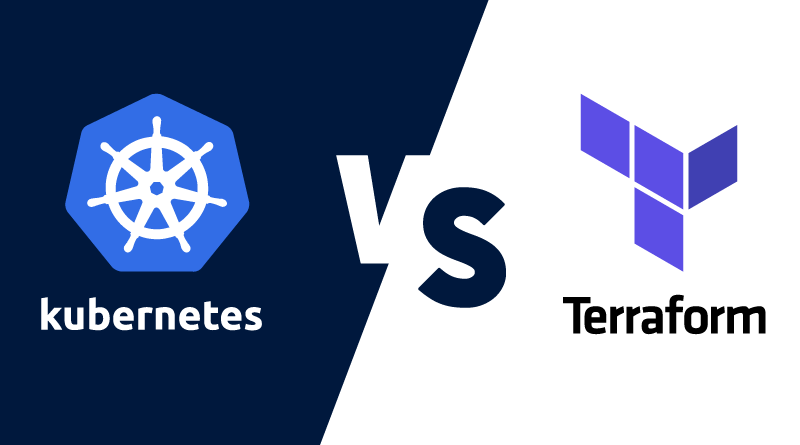DevOps makes the web development and applications development tasks easier for software developers. However, building the same is not an easy task without reliable tools or software. Kubernetes and Terraform are two major software tools that automate the coding and application deployment. Also, they work in IaC (Infrastructure as Code) environment.
Automation of software development eliminates human risk and enhances transparency. The development cycle of software is easy to automate with these automation tools. Only the automation part is the thing that makes them similar, but plenty of differences are there that distinguishes them.
In this article we will have a debate between Kubernetes vs Terraform.
Table Of Content
Kubernetes Vs Terraform: A Brief Explanation
– Terraform
To manage the safe and efficient infrastructure configuration of software, it gives a good automation feature. That is why Terraform is functional in any environment. Also, IT professionals scale, modify and make changes in cloud environments according to business requirements.
With Terraform, an IT team that works on the cloud infrastructure their productivity will increase. It is because this tool has a code sharing feature which ultimately expands Terraform’s functionality.
The US based HarshiCorp software company has developed this software to enable developers to work on the cloud computing infrastructure.
Related: Docker vs Kubernetes – Understand the Difference
– Kubernetes
Rancher Labs and Google developed this open-source software to manage multiple containers. With this tool, developers automate their software deployment across multiple environments. Self-recovery, load balancing and the auto-scaling are some of the Kubernetes features. Thus, developers easily scale applications with the command-based scaling option.
Pros and Cons: Kubernetes vs Terraform
Pros of Terraform
- Multiple resources can be used for multi-cloud deployments
- Prevents downtime
- Enhances the recording, tracking, management, and reporting of changes
- Syntax with declarative clauses
- Documentation that is comprehensive and easily readable
Check Fully Managed Cloud Hosting Plans by MilesWeb for Business Success!
Cons of Terraform
- The GKE (Google Kubernetes Engine) isn’t fully supported.
- Can’t handle errors.
- Rolling back feature is missing in this software. If you want to do the same, delete the entire managed object in coding.
- New releases come with bugs.
Pros of Kubernetes
- Perform the horizontal scaling of infrastructure. It means you can add nodes as per your capacity.
- There are no infrastructural lock-ins.
- Syntax with declarative clauses
- Ensures that replicas are always healthy and automates healing
- Container management tool backed by Google with extensive documentation
Cons of Kubernetes
- Mastering this software is not easy for beginners.
- Organizations need to adjust their workflows according to the K8s.
- Only cloud infrastructure orchestration is possible.
Related: Jenkins vs Kubernetes: Decoding Their Features
Difference Between Kubernetes And Terraform
In many blogs, you might have read about similarities between these two modern technologies. However, they are different from each other. Read the difference between Kubernetes And Terraform below.
– Purpose and Functionality
Terraform is an infrastructure-as-code tool used for provisioning and managing infrastructure resources across different cloud providers. It focuses on creating, updating, and versioning infrastructure components like servers, databases, and networks. In contrast, Kubernetes is an open-source container orchestration platform designed to automate the deployment, scaling, and management of containerized applications. While Terraform sets up the infrastructure, Kubernetes operates within it to manage workloads.
– Scope of Management
Terraform handles infrastructure provisioning at a broader scale, supporting multi-cloud and hybrid cloud setups. It allows users to define infrastructure configurations in code and manage services outside the Kubernetes ecosystem, such as DNS records, virtual machines, and firewalls. Kubernetes, however, primarily focuses on managing containerized applications within clusters, providing features like load balancing, self-healing, and horizontal scaling, making it more specific to application-level orchestration.
– Configuration Language
Terraform uses HashiCorp Configuration Language (HCL), which is declarative and easy to read, allowing users to define resources and dependencies explicitly. Whereas, Kubernetes uses YAML or JSON for defining resource configurations like pods, services, and deployments. While both tools rely on declarative approaches, Terraform’s syntax is more infrastructure-oriented, whereas Kubernetes’ syntax is optimized for container orchestration.
– State Management
Terraform maintains a file state to track the current form of the infrastructure, enabling efficient resource updates and management. It ensures that the infrastructure matches the desired configuration specified in the code. Kubernetes does not rely on a state file. Instead, it uses its internal AP server and etcd database to store the cluster’s current state and automatically reconcile desired states with actual states, providing dynamic control over container workloads.
– Dependency Handling
Terraform explicitly manages dependencies between resources using resource graphs, ensuring resources are created or modified in the correct order. It analyzes dependencies automatically based on configurations. Kubernetes, however, handles dependencies implicitly through controllers and operators. Also, it manages interdependent pods and services by monitoring their health and ensuring availability without requiring explicit dependency definitions.
– Use Cases and Integration
Terraform is an ideal option for setting up and managing infrastructural resources like servers, networks, and cloud services, making it suitable for DevOps teams handling infrastructure provisioning. Kubernetes, in contrast, excels at managing microservices architectures, scaling containers, and deploying applications in distributed environments. Both tools can complement each other—Terraform can provision Kubernetes clusters, while Kubernetes manages containerized workloads within those clusters.
Among the most popular modern DevOps tools, Terraform and Kubernetes differ significantly. In our research, we analyzed each tool’s strengths and weaknesses for developers and IT operators. With Terraform, resources can be declaratively managed across a wide range of cloud platforms. With Kubernetes, you can manage your container environments’ resources, deploy them, and manage load balancing.
FAQs
How does Kubernetes orchestrate containers?
Kubernetes orchestrates containers by managing their deployment, scaling, and operations within clusters. It uses declarative configurations to define applications’ desired state and employs controllers to ensure that the actual state matches the desired state. Kubernetes automates tasks like load balancing, rolling updates, and self-healing, ensuring high availability and reliability. It groups containers into pods, which act as manageable units and uses services to enable communication between them.
How does Terraform manage infrastructure as code?
Terraform manages infrastructure as code (IaC) by allowing users to define infrastructure components in a declarative language called HashiCorp Configuration Language (HCL). It creates and maintains a state file that tracks resource configurations, enabling automated updates and rollbacks. Terraform uses providers to interact with various cloud services, making it possible to provision and manage resources across multiple platforms, including AWS, Azure, and Google Cloud.
Which is easier to learn: Kubernetes or Terraform?
Terraform primarily focuses on infrastructure provisioning, making it more intuitive for beginners who need to define and manage resources. Kubernetes, however, involves a steeper learning curve as it deals with container orchestration, including concepts like pods, deployments, services, and clusters. To use this, users required a deep level of containerization and networking expertise. For those experienced with containers, Kubernetes often feels like a natural choice for infrastructure management, while Terraform tends to be a more beginner-friendly tool.
Which is better for CI/CD pipelines: Kubernetes or Terraform?
Both Kubernetes and Terraform are valuable in CI/CD pipelines, but their roles differ significantly. Terraform is ideal for provisioning infrastructure and managing the environment needed for CI/CD workflows, like creating VMs, storage, and networks. On the other hand, Kubernetes excels in deploying and managing containerized applications within those environments, making it a powerful tool for continuous delivery.
What are some common security concerns with Kubernetes and Terraform?
Kubernetes and Terraform each possess unique security concerns. Kubernetes faces challenges like securing API endpoints, managing secrets, and protecting against misconfigured role-based access controls (RBAC). It also requires constant monitoring to detect vulnerabilities in containers and enforce network policies to limit traffic between pods. Terraform’s security concerns include safeguarding its state file, which stores sensitive information, and managing access permissions to avoid unauthorized infrastructure changes.















